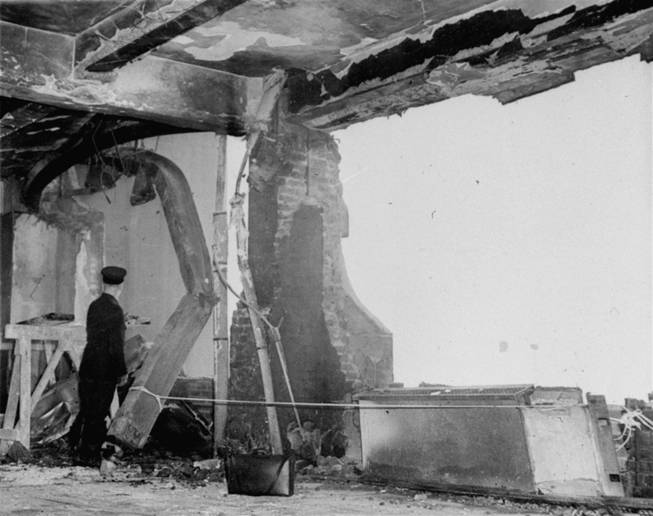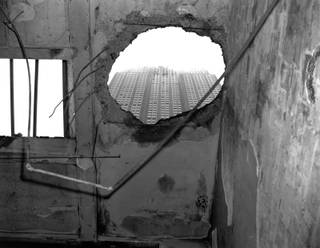
stf / AP
A fireman stands beside a twisted girder as he examines the gaping holes in the north side of the Empire State Building, on the 79th floor, evidence of the terrific impact with which a B-25 Army bomber crashed into the structure in New York, July 28, 1945.
Wednesday, July 25, 2012 | 2 a.m.
Sun coverage
Las Vegas and reality TV
- Las Vegas-based ‘Say Yes to the Dress’ pilot in the works (07-20-2012)
- ‘The Real Housewives of Las Vegas’? No! Glamorous ‘Vegas Moms’ (06-26-2012)
- The realities of reality TV: My experience on AMC’s ‘The Pitch’ (05-23-2012)
- In winning ‘The Pitch,’ SK+G makes Waste Management an offer it can’t refuse (04-30-2012)
- New Las Vegas-based reality TV show to take viewers inside South Point (02-07-2012)
- Reality TV — Vegas style (11-05-2011)
For more than 60 years, a small, melted hunk of metal lined with rivets has been an object of fascination and the subject of countless school show-and-tell projects for Henderson resident Irv Atkins and his family.
The artifact was discovered by Atkins’ father, Louis, in his 10th-story office in midtown Manhattan on July 30, 1945, two days after a B-25 bomber crashed into the 79th floor of the Empire State Building, which towered across the street from Louis Atkins’ office.
The crash, which occurred on a foggy Saturday morning, left 14 people dead and rained debris throughout the New York City neighborhood.
Atkins brought the piece home to show his family, and through the decades, it became an accepted part of family lore that the piece was from the crashed bomber.
After inheriting the artifact from his father and bringing it with him across the country in the late 1990s when he moved to Henderson, curiosity finally got the better of Irv Atkins, and last summer he set out to authenticate the piece of gray scrap metal.
“My father was a salesman, but I don’t think he’d make up something like this,” Irv Atkins said. “It was lying around for 67 years, so I said, ‘Why not? It’s worth a shot.’”
To aid him in is research, Irv Atkins contacted the PBS program “History Detectives,” launching a months-long investigation that culminated in an episode that aired Tuesday night.
In the episode, Atkins’ long-held suspicions were confirmed: The piece is real, most likely coming from a fuel tank door on the underside of the crashed bomber.
Authenticating Atkins’ artifact took researchers from New York City all the way to the desert of California, said Eduardo Pagan, a history professor at Arizona State University and one of the show’s co-hosts.
“It starts with good, old-fashioned legwork. You pick up the phone and start calling around, seeing who can help us identify this,” Pagan said.
Verifying the origins of Atkins’ piece of metal proved difficult, Pagan said, because it had few identifying markings and there are few other known pieces of the plane in the public sphere.
“From everything that we could gather, the place was cordoned off immediately. All sorts of officials rolled in and swept everything up. Where those pieces went, we don’t know,” Pagan said. “I thought there was no way in the world we could figure out where this piece was from. It took a lot of scratching our heads.”
Pagan and his team eventually found their answer at a B-25 bomber graveyard in California, where they visited an aviation expert and compared Atkins’ metal piece to fuselages and parts from other B-25 bombers collected at the site.
“Eventually, we landed on the right person,” Pagan said.
The expert deduced the bolt pattern and aluminum material proved that the piece of metal belonged to a World War II-era bomber. A subtle faded line on Atkins’ artifact where it had rubbed against other pieces of the fuselage gave the expert the clue he needed to confirm that the piece was from a B-25 bomber.
“It was really based on the bolt pattern and the reinforced nature of the piece of metal that can only go on one place on the plane,” Pagan said.
The news delighted Atkins, who told Pagan on the show, “It’s another facet to the story that I’ve been living with all these years. It’s something a little different but more amazing.”



Join the Discussion:
Check this out for a full explanation of our conversion to the LiveFyre commenting system and instructions on how to sign up for an account.
Full comments policy